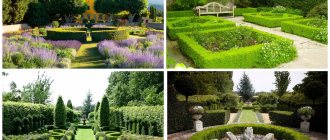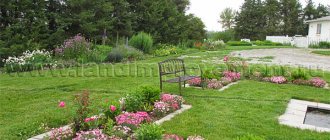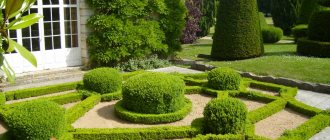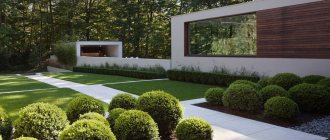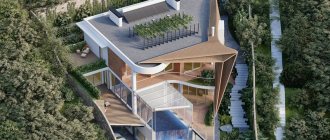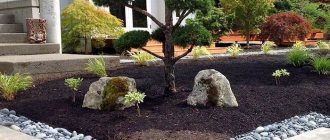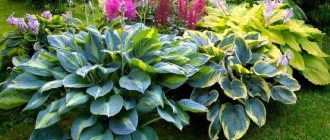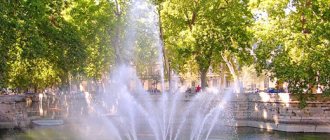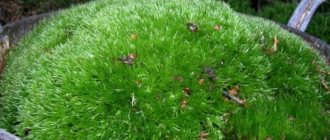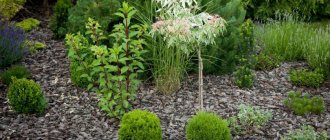The northern landscape stretches across the volcanic highlands of Iceland, the forests of Finland, the mountains and fjords of Norway, the grasslands of Sweden and the sandy plains of Denmark. It's phenomenally beautiful, and if that's the view from your window, why make a change? And if you are environmentally literate with a great love for northern flora and fauna, this style will be a godsend for your site. Scandinavian style in landscape design is an opportunity to create a cozy place in a country or summer cottage. Let's take a closer look at the features of Scandinavian landscape design.
Features of Scandinavian garden style
Scandinavians respect nature, striving to transform natural landscapes into landscape architecture, and to carefully and thoughtfully build and customize every element, from house coverings to garden paths. Respect for nature is a key feature of northern garden design. Nature is a kind of religion in Scandinavian countries. In Scandinavia, closeness to nature is considered a privilege. As the Scandinavians themselves say: “We have great respect for our surroundings - forests, lakes, fields and mountains. We are born and raised close to nature, acquiring knowledge of how to deal with the environment.” In the northernmost parts of Scandinavia, the growing season lasts about 60 days. The rest of the year is mostly a prelude to or recovery from winter. This must be taken into account when you are going to give your site the features of a northern landscape. The main style characteristics are green lawns with minimalist natural materials. The distinctive features of Scandinavian landscape design are:
- simplicity, restraint;
- functionality;
- naturalness;
- orderliness.
To create such a creative composition, wood sculptures, stone compositions, arches, gazebos, and comfortable benches are placed in the dacha space. A prerequisite is a large number of evergreen plants (preferably conifers). An original solution is to combine interesting sculptures with trimmed bushes of round and square shapes in one area. To create a landscape in the desired direction, you will need a plot of 6 - 8 acres in size.
Key elements of landscape design:
- Small lawn, no borders or flower beds.
- Natural looking lawn with wild plants.
- Rectangular paved areas.
- Rock garden instead of an alpine slide.
- Heather garden.
- Large boulders.
- Materials: wood, stone and galvanized metal.
- Minimum processing of all materials.
- Lots of containers for plants.
- Painting wooden structures in bright colors.
- Pond or small body of water.
- Small vegetable garden.
Scandinavian garden style: we use decorative elements from natural materials
are of great importance in the design of the Scandinavian style in landscape design . They are usually created from wooden material, after which they are covered with light-colored paints. But several displays should stand out with bright accents to attract attention. Benches are made of wood; special containers or wooden buildings are often installed next to them, where gardening tools are stored.
When decorating a space, preference is given to tables, chairs, and sun loungers woven from natural wicker. Garden decor is also complemented by:
- old broken clay jugs;
- carts made of wood without wheels;
- watering cans.
What kind of fences are used in the Scandinavian style of garden and dacha design?
Residents of northern countries do not make a fence on purpose; the space is fenced off with trees or shrubs. But even there you can find fences around the plots.
For the most part, fences and other types of fencing in Scandinavia are a combination of a maximum of natural wood and a minimum of iron. Fences are often constructed from the trunks of young coniferous crops, placing them at an angle to the ground (as in the photo). The posts are also made from the same wood. Also popular in Scandinavia are wicker fences made from thin branches, often used as a support for various plants and flowers.
Gazebo for the northern garden: characteristic features of the structure
If you want to complement the garden with the special features of the countries of Northern Europe, gazebos are installed. Country and garden buildings in the Scandinavian style are made of medium parameters, with windows (often unglazed). A table and benches are installed inside the structure. They can be either wooden, wicker, or soft, selected in garden furniture stores.
The main rule is that the building should not be bulky; wood or natural stone is used for decoration. The shade of the gazebo is light blue or white. A fashionable accent in decorating an arbor is large asymmetrical boulders. Near the structure there should be many flower beds planted with colorful representatives of the flora. If desired, a barbecue is installed near the building. Clay pots and wooden structures are placed in an open gazebo. An open gazebo is often complemented by wickerwork - figurines made of wicker, which are placed on tables next to the flower beds.
Garden design in Scandinavian style: selection of decorative decorations
A Scandinavian-style garden plot requires not only an insulated house with a terrace, but also various original elements of landscape decor.
Most often, the northern garden is decorated with the following elements:
- miniature houses of gnomes and elves;
- wooden figurines;
- bird feeders;
- bodies of water
The Scandinavian style in garden landscape design involves the installation of various figures, small buildings, grottoes, figurines, and images of fairy-tale characters in the arrangement of the site . Plants often serve as the basis for the creative creation of sculptures of various shapes from natural materials. When choosing decorative components, you need to observe moderation, combine imagination with an original approach, and advice from designers.
Selection of plants for such a garden
It is difficult to imagine a Scandinavian garden without evergreens. The main decoration of the garden area are pines, junipers, spruces and pyramidal thujas. Multi-tiered flower beds in Scandinavian design replace all kinds of outdoor pots and flowerpots. Hydrangeas, yews, and boxwoods look impressive in containers.
Low-maintenance boxwoods lend themselves well to pruning. Their crowns can be given original pyramidal and round shapes
A gazebo or recreation area can be lined with climbing plants. Ideal for these purposes: climbing beans, hops, morning glory, ivy, clematis.
Typical of the Scandinavian garden are miniature greenhouses, under the roof of which heat-loving ornamental plants are grown.
When creating flower arrangements, the most popular are: lavender, rhododendron, peony, poppies and daisies, as well as any wildflowers
Elegant lawns of phlox, asters, calendula and flax, like islands, are found every now and then in different corners of the garden. These joyful oases add a special charm to the Nordic garden. And the atmosphere of the Scandinavian tribes will be created by semi-wild cereals.
The following are ideal for arranging rocky gardens: Carpathian bellflower, Alpine carnation, sedum and creeping gypsophila.
The perimeter of the site is often framed by trees. Mixed plantings of lilac, birch, aspen, spruce and pine look unusually picturesque
When choosing plants, you should be guided by the principle that the overall appearance of the garden should remain discreet and simple, and only its individual elements can stand out with bright colors.
Tips from landscape designers for decorating a garden in a northern style
Here are some recommendations from experts on arranging a garden plot in the Scandinavian style
Be in nature more
During the warmer months, spend as much time outdoors as possible. In the kitchen, bedroom or living room, install large windows and, if possible, access to the garden, which you can access in the summer. Set up a summer kitchen with a couple of shelves under the eaves where you can store plates and cups. Nearby, install an outdoor faucet for washing dishes, a dining table with chairs and a grill. This will be an incentive to spend more time in the garden.
Use recycled materials in your design
Use natural and recycled materials. Weathered wood, old well-kept benches and metal buckets or piles turned into flower pots will give your site simplicity and modesty.
What color palette to use
Use colors that are often found in northern nature. Gray, brown, white and green backgrounds will complement the plants and trees in the surrounding Scandinavian landscape.
Minimalism in the Scandinavian garden
Take a minimalist approach to design elements such as paths and fences to allow them to blend in with the natural surroundings of your property. Don't try to manage your garden. After flowering, let your plants' seeds spread on their own. Plant your plants between the stones. Keep your plants minimally pruned.
Look after your plants
Pay attention to the plants that bloom in your garden, how happy they are with sunlight, soil and moisture. Let them spread as they please and don't waste time on crops that don't do well in your garden.
Use light wisely
In Scandinavia, poor sunlight is a fact of life. In your garden, you can determine how light moves through your area. What elements - outbuildings, tall trees - create shady areas in the garden. How sunlight enters your garden in spring, summer and fall. This will be the main criterion for choosing where to plant your plants.
Arrangement of a decorative pond
The same stones and moisture-loving plants are used as a frame for a decorative pond.
A necessary attribute of a northern garden is a small waterfall or decorative pond, the surface of which is decorated with graceful beauties of lilies.
If it is not possible to arrange a pond on the site, you can add a touch of the water element to the atmosphere by installing a tall tub of water.
Keep an eye on the exterior
Not only the interior decoration should reflect the character and principles of the Scandinavian style, but the exterior should also be closely related to the interior. Take care of the lawn, make paths from wooden planks, create impromptu flower beds using boulders, and plant climbing plants near the house.
If there is a garden on the territory, be sure to take advantage of its thickets and place a small gazebo or hang a hammock. In general, the courtyard of a country house is an ideal place for various art installations. Here you can place your works made of clay, crafts made from natural materials, try your hand at trash art by planting plants in rubber boots or old teapots.
You will achieve a harmonious Scandinavian interior in a country house when you play along with the age of the house, filling it with those interior and household items that are close in spirit. Don't try to modernize it, but rather maintain its charm by adding a little organization and coziness.
Open space
Scandinavians love space and do not like partitions at all. Therefore, it would be appropriate to combine the kitchen with the dining room or even the living room, so that it is one large and cozy space, conventionally separated by design techniques and decorative elements.
It will be especially useful to combine several rooms in a country house if it has a small area.
Garden furniture with character
Wooden elements of garden furniture help ensure a harmonious combination with nature.
So-called container benches, in which it is convenient to store all kinds of gardening tools, have also become widespread in landscaping. Thanks to these convenient, functional designs, Scandinavian gardens are also called “container” gardens.
Original garden figures and oddly shaped driftwood help to add expressiveness to the image.
When arranging a site, wicker chairs, sun loungers and tables are most often placed not in open areas, but in shady corners under the canopy of trees.
Scandinavian style is, first of all, a successful combination of small details that create a single image full of harmony and perfection.
Color solutions and materials
In winter there are no bright colors, so the Scandinavian style often uses evergreens and primroses, as well as bright decorations (often instead of fruit trees and garden plants). It is entirely built on natural materials - mainly stone and wood.
A lot of stone is an excellent design find where plants do not take root well, but it makes no sense to cover the entire area with specially treated stones or boulders. This natural material, with proper design and planting of living plants, always looks very advantageous, but an excess of stone destroys the very concept of the garden.
Stones are used in various sizes, singly or in groups. To prevent them from looking monotonous and uninviting, choose a different type of material - sea pebbles (facing and paths), small multi-colored stones, marble and granite (preferably crushed, but processed ones are also possible), natural cobblestones and boulders.
Spacious terrace - the heart of the dacha
Even the smallest house will be transformed and become more spacious if you create a beautiful and cozy terrace. It increases the usable area of the house, literally becoming an additional room. You will need quality wooden boards, tools and a couple of days off.
Place a wicker chair, several cozy wooden chairs and a table on the terrace so that you can have tea, read your favorite book or enjoy nature in silence.
Layout features:
- All forms tend towards stability and squareness.
- Accents and contrasts are required. Even if there are few of them, they should be bright.
- There are few garden accessories, but they can be large.
- Open plan (conditional zone boundaries).
Color solution:
- A combination of a restrained, strict color scheme (where light colors and natural shades predominate) with very bright colors: orange, red, yellow, blue. Metal color.
